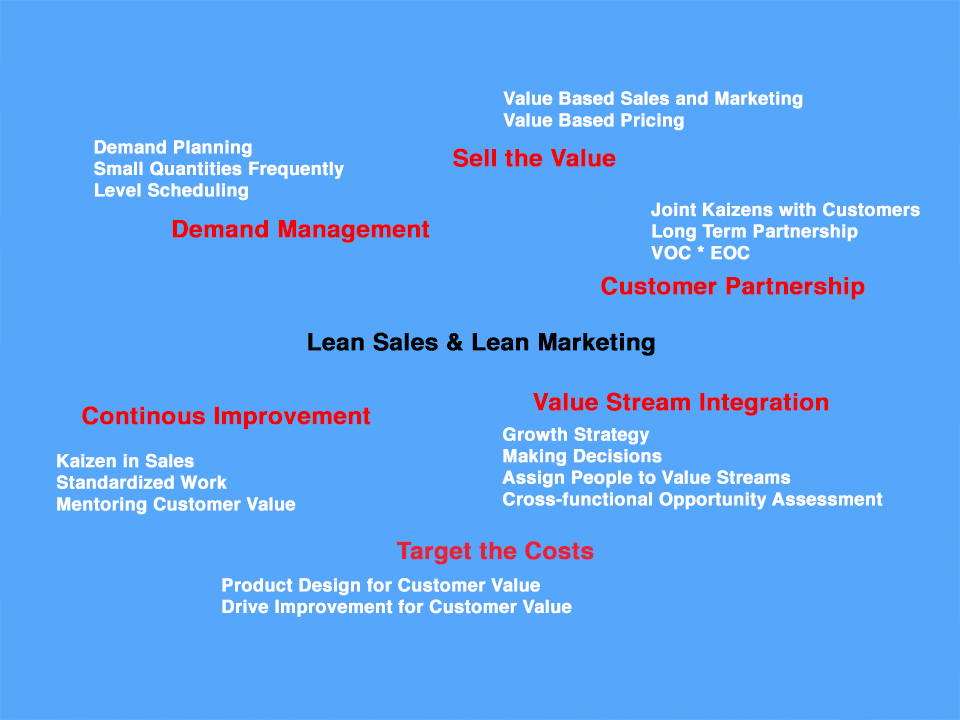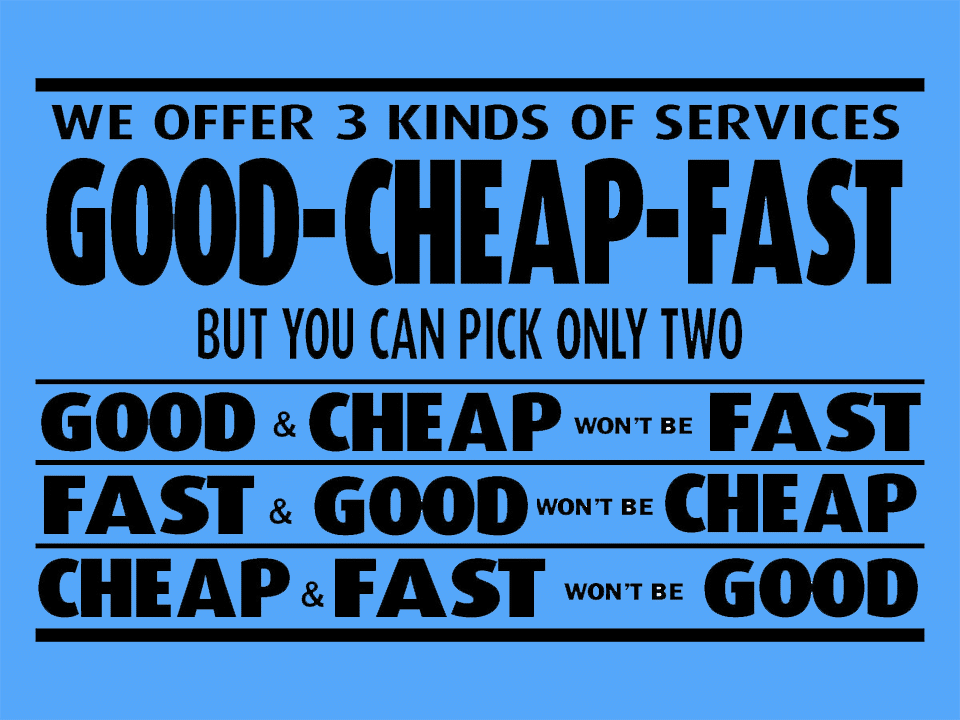Lean Thinking in Sales and Marketing
Many companies embarking on a lean transformation make a serious mistake: they view lean as a manufacturing or production issue. In fact, lean manufacturing can only be successful if all aspects in the company are transformed through lean thinking. Sales, marketing and even portfolio management are areas that often go unnoticed in companies.
In marketing and sales, the focus must be on customer value. It is important to organise a constant flow of demand and at the same time to standardise and continuously improve the work. However, this is not only about better throughput times and cost reduction, but also about creating customer partnerships. Without customer partnerships, companies are not truly “lean” and do not create customer value to the fullest extent.
The customer as a partner
The almighty keyword in Lean is “sustainability”. Lean organisations do not look for a one-time sale, but strive for a partnership relationship with their customers. The issues of value-based sales and marketing are paramount to customer partnerships, as this partnership is based on mutual respect and shared benefits. Lean living organisations seek to work cooperatively for mutual benefit rather than engage in these debilitating power struggles.
Example:
An IT managed service provider understands that its client needs to reduce its overall costs for IT maintenance and management. Together, the two work on due diligence and continuous improvement (kaizen) to eliminate waste and improve their processes in both organisations. The resulting cost reductions can be shared between the two organisations and there may even be a possible price reduction:
- If the cost reductions occur at the supplier, the benefit is passed on to the customer through price reductions.
- If the majority of the cost savings occur at the customer’s end, then the customer has achieved its cost reduction goal without the provider having to reduce its prices.
No matter how you slice it, there is a mutual benefit for both parties.
Annotation:
Clearly, a company that wants to adopt the Lean approach to customer relations, cost savings and pricing will need to change its purchasing process and performance measurements. When a traditional company focuses heavily on standard costs and purchase price variances, this motivates and supports toxic behaviours. The task of Lean companies is to eliminate these measurements and replace them with measurements that motivate collaborative relationships and lowest total cost through process improvement.
Concepts of value-based sales and marketing
There are a number of concepts commonly associated with Lean Sales and Lean Marketing:
If we look closely at these concepts, most of the features of a Lean approach to selling and marketing products are actually influenced by a value-based approach. As soon as we realise that a correct assessment and also a carving out of the customer’s value is important, we will see a drastic change in our approach to the customer.
De facto, most companies already have sales people who intuitively follow a value-based approach. They actually realise that the key to winning new business and thus growing the company is to create value for their customers. Moreover, they need to use this knowledge to develop products and services that optimise or maximise customer value, and they recognise that prices need to be aligned with the value created for the customer.
Even though many companies still stick to the old school of cost-plus pricing, smart salespeople have already realised that the customer will only pay a price that is commensurate with the value they get for the products and services offered. They also know that the customer does not care about the costs incurred in the company to provide the service or product.
Understanding value creation for customers
In addition to understanding Lean principles as described in the book “Lean Thinking” by Womack and Jones¹, the starting point for understanding customer value is the customer themselves. In professional Lean organisations, sales professionals spend a lot of time with their customers to identify and understand their needs. It is about translating or mapping these needs into services and products.
There are a whole range of components that create value for the customer, e.g.:
- transforming commodity services into customised services
- a unique product / service (niche)
- a superior product / service (quality)
- creating esteem or prestige in connection with your products and services
- providing complete solutions to the customer’s problems and needs
- lowering the life cycle costs of products
- a product / service that reduces costs or increases sales for the customer
- services that provide short lead times, flexibility, collaborative relationships, reliability, accountability, etc.
Clever sales and marketing people have now figured out that they can combine Lean Thinking and creating customer value with the 8 important (underlying) reasons why customers actually buy, namely:
- safety
- prestige
- curiosity
- profit
- health
- (individual) fulfilment
- convenience
- sociality
Once you know and understand how to create value for your customers and link it to the right benefits, you can start quantifying those values.
Value-based prices and offers
Basically, the starting point for calculating value for the customer is to know the base price – the amount the customer pays for the products or services that are similar to the ones you want to offer. Once you know the base price, you can calculate the amount of savings or increased revenue the customer would experience if they used your services or products.
Most of the time, the clear or distinct benefits that are calculated are financial. The so-called ‘soft’ benefits are more likely to be things like convenience or risk reductions, short delivery times, guarantees or very exclusive arrangements. Calculating these soft benefits is relatively difficult; it usually requires close collaboration with the client or the client’s clients to understand the value that can be created by corresponding benefits. So some due diligence is required in gathering information from customers, conducting surveys, researching markets and experimenting with pricing.
Let’s say you succeed and you have figured out the value that your service or product creates for your customer. Now you can move on to pricing your service or product. Example:
A product creates 300.00 USD more value than the previous similar product that was priced at 450.00 USD, then you are automatically faced with the question of how much of the extra 300.00 USD you keep and how much you pass on to your customer. The answer to this question may determine whether you sell less product for a higher price or vice versa. It is at this point that a sound understanding of the price elasticity of demand is valuable.
Companies that predominantly use cost-plus approaches often find it difficult to translate their thinking to value-based pricing. They need to take time to make appropriate adjustments to their existing products. However, if they introduce new products into a market, these can henceforth be based on real values from customers. For sales and marketing, this means that they are able to give their customers a (logical) rationale for prices based on the benefits the customer actually derives from using their product. As a consequence, this leads to higher turnover, profitability and even a better informed and empowered sales force and, of course, a harmonious customer relationship. This is how the customer becomes a partner.
Conclusion: lean thinking in sales and marketing
Lean thinking is not just an approach for manufacturing or production, it is a way of thinking for all areas within a company. And only if all areas of an organisation participate can the approach be successful in the long term. For sales and marketing, this means that the way of cooperating with customers is changing. Customers become real partners beyond “usual marketing statements”. This requires a lot of effort, as for example the exemplary examination of the true values of a product or service for customers shows.
Do you know this image or this truth?
Notes:
Tom Alpers is available for an exchange about Lean Thinking in Sales and Marketing. And of course you can also exchange about integrating sales into a value stream organisation, the power of team selling or a target costing process. Just write to him on LinkedIn or by Mail.
[1] James P. Womack, Daniel T. Jones: Lean Thinking: Ballast abwerfen, Unternehmensgewinn steigern

Tom Alpers
Tom Alpers, born in 1971, has been at home in information and communication technology for more than 20 years. As an independent entrepreneur and also as an employee, he has become acquainted with various perspectives and currents, which confirm his work in mediations. This is reinforced by predominant activities in an international environment.
His great professional interest is in lean thinking, process optimisation and automation, which he always sees as driven by the search for value creation. Innovation and continuous improvement always drive him to keep his finger on the pulse of the times and to tear up encrusted structures and give organisations the opportunities to transform themselves. Tom Alpers is happy to assist with a strong hands-on mentality.
For him, knowledge is a commodity as well as experience is the gift of life, sharing both leads to wisdom.

